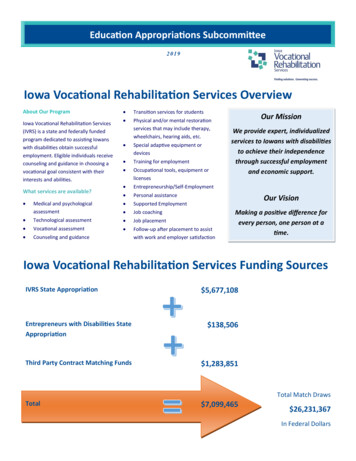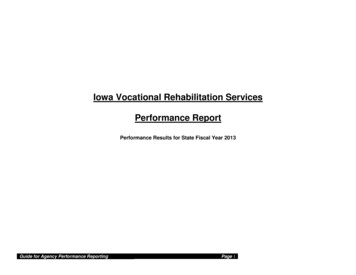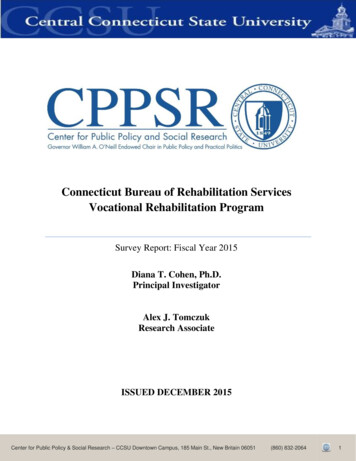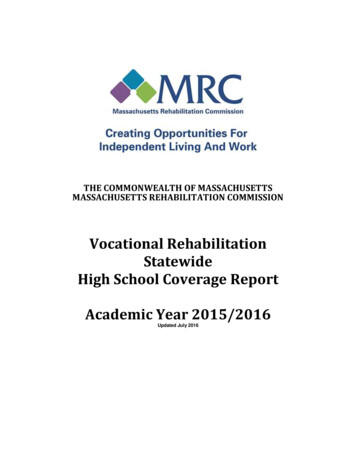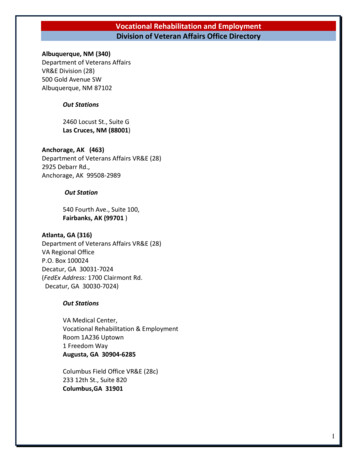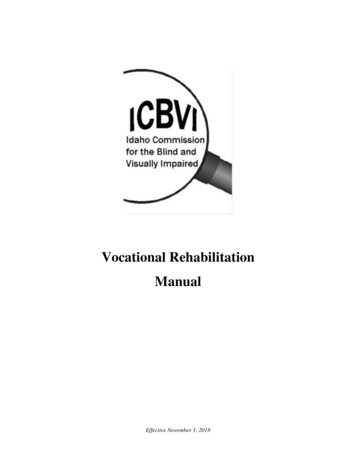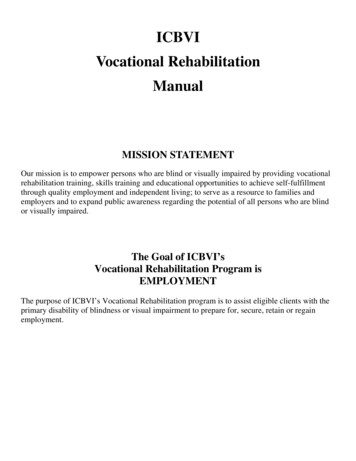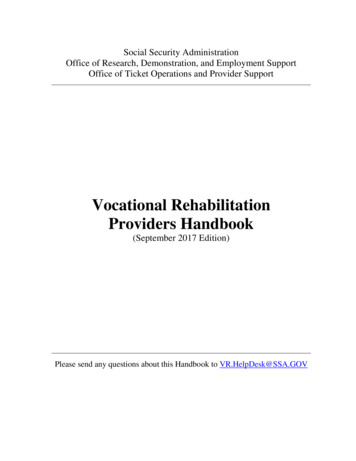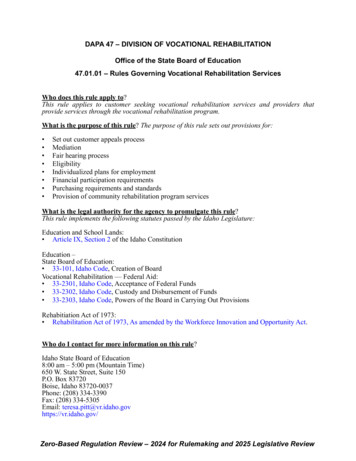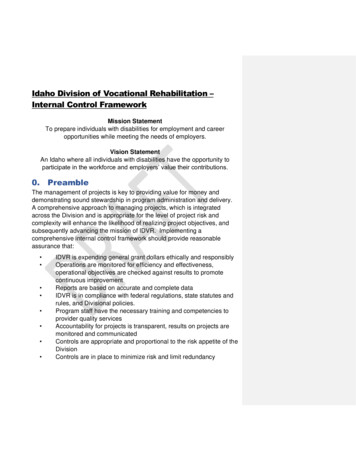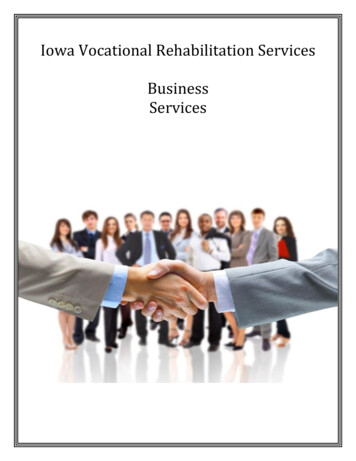
Transcription
Iowa Vocational Rehabilitation ServicesBusinessServices
Iowa Business Relations StructureMISSION:The premier partner for workforce solutions linking talented and qualified applicants with disabilities topublic and private businesses by learning the unique culture, skills and demands of the industry toensure employment success; additionally providing business with workforce resources and supportservices.GOALS1. Work with businesses and other community partners to develop long lasting businesspartnerships that result in multiple employment opportunities2. Develop strong and meaningful partnerships3. To serve each county’s business based on their geographic area and needs as a single pointof contact.4. Supporting businesses in hiring, retaining and accommodating and promoting persons withdisabilities in their workforce.5. Statewide consistency of business outreach and services6. Branded business services including newsletters, email blasts, success videos and businessservices bulletins7. Position self as a staffing resource8. Identify wider range of choices for our candidates9. Identify businesses willing to offer employment first optionsPRIMARY FUNCTIONS:1. Assist counselors in obtaining meaningful business information to utilize to help our jobcandidates have the skills for the job as well as making sure it is a good fit culturally.2. Using the job analysis to learn the soft and hard skills necessary for the job as well as theycultural aspects and using this for referrals to the business by also completing a job analysison the job candidates to show the fit, gaps and how to fill the gaps through accommodations3. Providing accurate and up to date labor market information for counseling and guidance.4. Preparing our job candidates to have the proper skills necessary as well as fit into theenvironment.5. Building solid relationships with business by listening and using motivational interviewing tosolve problems.6. Building relationships between our business and educational partners to provide jobcandidates with mentors in the community in the area of their career goals, providing careerexpos and fairs as both at the school and business7. Facilitate training to businesses in the importance of diversity in the workplace, the valuepersons with disabilities bring to the workplace, sensitivity training, disability etiquette,information on responsible accommodations, training on the ADA and ergonomics8. Provide information on business services to local Chambers, SHRM, rotaries, ECI groups,sector boards, and other professional groups.For more information about this manual or assistance with partnering with business and industry;please contact:Michelle Krefft, Business Consultant for IVRSmichelle.krefft@iowa.gov515-281-02642 Page
Table of ContentsEMPLOYER DEVELOPMENT FUNDAMENTALS1.Networking . . . 6Why is Networking Important . . 68 Tips to Networking . . . 7Networking File Cabinet . . 8Rapport . 92.Building A Relationship 10How to Establish Accounts . 10Preparing For The Meeting . 11Setting Up The Appointment . 11The Initial Visit . 12Business Intake . 13Questions You May Ask . 14Closing The Visit . 16Follow Up The Visit Form . 16Maintaining the Account . . 16Services We Offer . 18Using Social Media in Today’s Employment Market . 20Profiles . 21LinkedIn.com . 21Facebook.com . 21Twitter.com . 21Google . 21Blogs . 21Seven ways to use social media to land a job . 22WIOA partnering- how to partner to build relationships . . 23Employment First and employment relationships . 243.Reducing Risks and Costs . 25Improving Business’s Bottom Line 26Why It Makes Sense to Hire People With Disabilities 284.How to Guides . 29Developing an Employer Account . 30Preparing a Consultation Report . 33Taking a Job Order . 36Job Shadow . 39Informational Session . 41Prescreening A Candidate . 43Job Analysis . 46ADA Consultation Report 60Employer Based Training 683 Page
Section 503 linkage agreement . 70Conducting An Employer Focus Group . 73Work Opportunity Tax Credit . 75Access Related Incentive- Iowa Assistive Device Tax Credit . .76Wage Related Incentive Iowa Small Business Tax Deduction . 77Architectural/Transportation Tax Deduction . . 78Small Business Tax Credit . 79Save A Job . 80Ergonomic Assessments . 825.On the Job Training . 836.Employer Development Documents and Forms . 100Employer Development Form . 101Contact Log . 102Employer Consultation Cover Letter/Report Form 103Job Order Information Form . 104Comprehensive Job Analysis Form . 105Employer Focus Group Questions . 116Position Description 1 . 117Position Description 2 118Customized Training Plan 119Customized Training Agreement . 122OJT Customized Training Agreement . 125Staff Job Shadow Form . 128Informational Interviewing . 129Reference Check 130Business Intake . 131Job proposal 133Linkage agreement for Section 503 134Linkage Agreement 1357.Your Favorites . 1364 Page
EmployerDevelopmentFundamentals5 Page
NetworkingNetworking is the best way to meet people. This can happen in a variety of ways for all staff! Here aresome tips for beginners: Chamber of Commerce events: Go to the luncheons so you can learn about what other businessesdo as well as tell them what you do. Chamber After Hours: Go and meet people- just talk to them and get to know them. Rotary: Talk at a noon rotary about what we do. Church: Talk to others about what they do for work- listen. Your contacts: Talk to them about what they do- listen and learn.Networking does not always happen Monday through Friday 8-5. Networking happens during our naturaleveryday occurrences. It may happen at the grocery store, dropping off and picking up your childrenfrom daycare, while you are out to eat, while you are getting your oil changed, at your child’s sportingevents, or even while you are out on the golf course. Whenever it happens, be ready to talk business. Thiscan help make your job a whole lot easier. Just by doing what you do every day, you are setting yourselfup for a potential appointment with a business and we all know that getting those appointments can bequite difficult.Why is Networking Important? Networking- generating new leads and contacts is the single most crucial activity you can performto make business leads that hire your job candidates.“It’s not what you know, it’s who you know.” Everyone has a network, even if you don’t realize it. Apersonal network is that group of people with whom you interact every day; – family, friends,parents of friends, friends of friends, neighbors, teachers, bosses, and co-workers. With thesepeople, information and experiences are exchanged for both social and potential professionalreasons. Networking occurs every time you participate in a school or social event, volunteer in thecommunity, visit with members of your religious group, talk with neighbors, strike up aconversation with someone at the store, or connect with friends online.When you are networking for the purpose of career development, talk with friends, familymembers and acquaintances. Most people learn about job openings through friends, relatives orothers in your personal network, and because each person in your network has a network of theirown, your contacts growth potential is limitless. The importance of this is that more often thannot, hiring managers would rather talk to a potential candidate that has been referred by someonethey know or already employ. Even if there is not currently a job opening with them, networkingleads to informational interviews that can help you learn about their business.Informational sessions are not the same as job interviews, but they are the most effective form ofnetworking. In fact, one out of every 12 informational interviews results in a job offer. This isremarkable considering the fact that research indicates one out of every 200 resumes (somestudies put the number even higher) results in a job offer. It is important to know that 80% of alljobs are filled before they are even advertised; this is the hidden job market. Having an extendednetwork can get you where you need to be when these jobs come up.6 Page
Tips to Networking8 Tips to Networking:1. Giving vs. Getting2. Be Present3. Listen More Than You Talk4. Think Long Term vs. Short Term5. Don’t Over Commit or Feel Guilty6. Be Honest7. Take Action Immediately8. Only Go To Things That Excite YouNetworking can be taught but we have to think about it differently than one specific approach or readingabout it in a book. We have to experience it. Think of networking as “touches”. Whether needing theinformation today or not, whether the relationship is important or helps us in the here and now, it getsstored away.Close your eyes and envision a file cabinet full of drawers, cubbies or nooks and crannies and make it asbig or as small as your network dictates. Every time you meet someone, no matter how brief, call it a“touch”. Your goal is to walk away from every touch with a bit of information to store in your file cabinet.So when you meet someone in the grocery store and you recognize the logo on their shirt, or a certainthat they are wearing, make a reference to it. A conversation develops and you discover that this personraises horses. You know nothing about horses, you may not even care, but you store that informationaway because it may be important to someone you “touch” later.Later on, you meet another person who sells horse trailers. Again, it doesn’t help you but you reach intoyour file cabinet and connect the grocery store “touch” with this “touch”. Who’s the hero? You justestablished a trusting relationship with a business that sells horse trailers. Do you think this will get youin the business?7 Page
Networking File CabinetThe following is one way to identify those in your or your network.Who is in my Network File Cabinet?Personal ContactsWhat do they do:Name:Professional ContactsName:Business ContactsName:Educational ContactsName:Community ContactsName:8 Page
RAPPORTRapport is the core to having and maintaining meaningful communications, because it helps toestablish Trust! Without trust, you will face enormous difficulties in your relationships.Rapport is defined as: “A state of mutual trust and respect existing between two or more people. Rapportis the primary basis for all successful communication.”What happens when trust does not exist between you and the business? Phone calls are not returned. You can’t get a meeting. Your job candidates are not called in for an interview when a referral is made. Bottom line you don’t have that business as a resource.How do you build rapport? First, make an effort to find out if the person you’re interacting with has anyof the following in common with you: People you might know inside and outside of the business. Industry or trade associations you belong to. Hobbies you are interested in. Geographic location where you grew up or have lived. Family members. Restaurants frequented. Church. Sporting events. Where your kids go to school or daycare.Why is finding out what we have in common so important? Think of what you like about a very goodfriend. Do you like the same things? Do you have the same hobbies? Now answer this question ashonestly as you can, “Are they just like you?”The answer is “Yes.” We like them because they have interests similar to ours. We have allexperienced meeting new people and within a few minutes, we decide if we like them or not. Why isthat? Because we are deciding if they are just like us.We tend to trust those who like the same things we do, versus those who do not. This is not the onlything, but this is very important in gaining rapport.9 Page
BUILDING A RELATIONSHIPHow to Establish AccountsThere are several ways to develop relationships with business and industry. Take the time to get toknow business professionals as people. Building relationships with them is very similar to how youmake friends. Remember, it’s not just about placing a job candidate into their business; it’s aboutcreating a connection between you and the business.One of the first steps in building a relationship with a business is getting to know something about thebusiness. A good way to start this process is by researching the company before meeting with them.Go on the web and search the business to learn about their industry, what positions they have, andtheir history. Having some initial information about the business will be helpful when you first meetthem so you can ask informed questions and give knowledge-able answers. The focus of your firstmeeting will be asking questions and listening to learn about their unique needs. During yourmeeting, ask them about areas that may be a challenge for them and think about ways that IVRS couldbe a part of the solution. Always have answers ready for any objections they may have or explain thatyou will need to get back to them if you do not have the answer to a particular question they pose.Once you have established yourself, eventually they will say, “Tell me about what you do.” At thatmoment you know that they want what you have; your job candidates and/or the professionalservices IVRS can provide to them!Does this happen overnight? Absolutely not—it takes a long time to build this trust. Once you havegained that trust, keep this in mind: UNDER PROMISE AND OVER DELIVER. For example: If a businesssays they need something from you and you tell them that, based on your schedule, you could providethe information to them by Friday and end up getting it to them by Wednesday, they feel as if they areimportant to you because you got them what they needed before the projected date. Mostimportantly, follow-through. Never promise something and then drop the ball. Just like anyrelationship, this ruins their faith in you and IVRS.The key to a professional trusting relationship is to begin talking about their business. Do not start therelationship talking about you or your job; ask questions that will lead to answers about theirbusiness needs, opportunities for growth and gaps. Finish by addressing those needs, opportunitiesand problems with IVRS solutions.Always give people more than they expect. The real way to differentiate yourself from the competitionis through service. Finding a way to make your business partner feel special is a powerful advantage.10 P a g e
PREPARING FOR THE MEETINGDO YOUR HOMEWORKPrior to your visit with the business, learn about them!1. Research the business! You will demonstrate professionalism and interest by having facts andhistory about the business prior to the visit. Things you can do to learn more:a. Research on lineb. Visit the business (if possible) as a customer and make observationc. Talk with your networks to see if you have any common networksd. Look the business up on Facebook and Linked in- do they post a lot of openings?e. Look through IWD (Iowa Workforce Development) job postings to find common threads onpositions they are advertising for frequentlyf. If you belong to a club or other organization that the business is also a participant of- get toknow employees that work thereSETTING UP THE APPOINTMENTWARM CALL- A warm call is where you have established some kind of a connection and are able to havea connection make contact with the business to let them know you will be contacting them. You will getthe contact information from your connection and this is the easiest way to make the appointment.1. Call the businessSAMPLE: “Hi Jenny! I am friends with Teri and she suggested I give you a call. She said you are really busywith hiring lots of new staff. I’m Michelle and we work with Iowans on employment and in order to helpyour business get the best candidates possible, I would like to schedule a time to learn more about yourbusiness. Can you give me a day that might work for you?”2. Email the businessSAMPLE: “Diane, THANK you for the introduction! Jill, I am super excited to meet you and discuss apartnership! IVRS is an agency that helps persons with disabilities gain and maintain employment. Werecognize that even more important than the hire is the retention. The first step in building a partnership isto tour your facility, learn about the culture of your work and listening to your needs, your current andfuture demands as well as the skill sets you are looking for. I would have time to meet with you on July 6th,22nd and 23rd. Would any of those work? Again, looking forward to it!”COLD CALL- A cold call is where you call the business without any connection, names or information.You are calling in an attempt to get information and set up an appointment.1. Call the businessSAMPLE: Hello, my name is Michelle and I am calling to see if I can schedule a time to learn more about yourbusiness. I understand that retention is just as important as the hire and so finding the right fit is critical.We work with Iowans on employment and in order to help your business get the best candidates possible, Iwould like to schedule a time to learn more about your business. Can you give me a day that might work foryou?”11 P a g e
2. Email the businessSAMPLE: “Hi Diana!“My name is Michelle Krefft and I am the business consultant for IVRS & I am very excited to meet with youand learn more about your business and what you do! I am wondering if I could set up a time with you inFebruary to allow me to learn more about Musco lighting and talk a little bit about the needs that you havethere and ways that IVRS might be able to help you? I am available on Feb. 10, 11, 12 & 26. If any of thesedays work for you, would you be able to pick one and a time and I will come to your business. I am superexcited to meet and partner with you!! Have a great day!”Once your appointment is scheduled, confirm it with an email, an outlook invitation or a letter to remindthem and verify the time, day and address. Verify if you need special clothing, shoes or if your hair needsto be in a ponytail. It is wise to always have closed toed shoes in your car and a ponytail holder aroundyour wrist if you have long hair. This is a good time to look up driving directions and the length of time toget there for preparation for the visit. This should be put in your planner along with proper commutetimes.THE INITIAL VISITIf this is your first interaction with the business, use this opportunity to schedule the visit. You shouldnot stop in for more than 5 minutes unannounced.Arrive at the business with a couple of minutes to spare and ask for your contact. Dress in accordancewith the business. If you are going onto a fact
Feb 03, 2019 · Iowa Business Relations Structure MISSION: The premier partner for workforce solutions linking talented and qualified applicants with disabilities to public and private businesses by learning the unique culture, skills and demands of the industry to ensure employment success; additionally providing business with workforce resources and support
